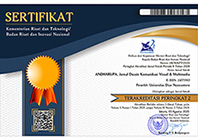Jiwa Entrepreneurship Penggerak Desain
DOI:
https://doi.org/10.33633/andharupa.v4i02.1966Abstract
AbstrakAkhir-akhir ini industri kreatif berkembang seiring arus globalisasi dan pasar bebas. Kondisi ini menggairahkan industri-industri kreatif baru bermunculan yang dapat menjadi andalan suatu daerah bahkan menjadikan predikat kota kreatif. Industri kreatif yang berkembang di bidang desain tiap kota dapat meningkatkan citra daerahnya, meningkatkan devisa, dan mengatasi pengangguran. Ada empat penggerak kreatif yaitu akademisi, pemerintah, kreator, dan pengusaha yang menjadikan industri kreatif semakin subur. Berbagai cara telah dilakukan oleh empat unsur tersebut hingga suatu kota menjadi terkenal, maka perlu dikaji melalui metode telaah kepustakaan dan pengamatan dengan memperhatikan teori dari Williamson tentang jenis kewirausahaan dan Philip Plus tentang tahapan dalam berkanya kreatif. Hasil diperoleh bahwa akademisi mengarah ke jiwa wirausaha yang inovasi, pemerintah mengarah ke wirausaha yang meniru, kreator mengarah ke wirausaha yang hati-hati, dan pengusaha mengarah ke wirausaha yang pemalas. Untuk memperkuat pembahasan maka diperkuat oleh hasil karya nyata kewirausahaan sebagai inspirasi orang lain dan bermanfaat dalam kehidupan masyarakat. Kata Kunci: kewirausahaan, industri kreatif, kreator  AbstractLately, the creative industry has evolved by alongside the flow of globalization and free markets. This condition stimulates new creative industries emerging that can become a mainstay of an area even make the creative city becomes a predicate. Creative industries that develop in the design field every city can improve the image of the region, increase the number of foreign exchange, and tackling unemployment. There are four creative movers: academics, government, creators, and entrepreneurs that make the creative industry particularly fecund. Various ways have been done by the four elements until a city became famous, it needs to be studied through the method of literature and observation by taking into Williamson's theory of the type of entrepreneurship and Philip Plus’s theory of the stages in the creative work. The results obtained that academic has been leading to innovating entrepreneurship, the government has been leading to imitative entrepreneurship, creators have been leading to fabian entrepreneurship, and entrepreneurs have been leading to the drone entrepreneurship. To strengthen the discussion then reinforced by the real work of entrepreneurship as the inspiration of the others and useful in social life. Keywords: entrepreneurship, creative industry, creatorsReferences
Aleinikof, Andrei G. 2012. Mega Creativity Five Steps to Thinking Like a Genius Yogyakarta: Imperium.
Bourdieu, Pierre. 2010. Arena Produksi Kultural: Sebuah Kajian Sosiologi Budaya, Yogyakarta: Kreasi Wacana.
Clegg, Brian & Paul Birch. 2001. Instant Creativity. Jakarta: Erlangga
Featherstone, Mike. 2008. Posmoderisme dan Budaya Konsumen, Yogyakarta: Pustaka Pelajar.
Hakim, Aziz Adisurianto & Yanuar Rahman. 2017. Perancangan Media Promosi Perusahaan Arnis Wigati, Jurnal Demandia, Vol. 02, No. 01, Maret 2017.
Kompas. 2011. Ekonomi Kreatif Kian Menjanjikan, Jakarta: Kompas, 31 Oktober 2011
Kompas. 2012. Jumlah Wirausaha di Indonesia Masing Kurang, Jakarta: Kompas, 13 November 2012
Kunthi. 2016. Launching Publikasi Ekonomi Kreatif 2016, https://www.bps.go.id/ news, 16 Desember 2016
Moelyono, Mauled. 2010. Menggerakkan Ekonomi Kreatif Antara Tuntutan dan Kebutuhan, Jakarta: Rajagrafindo Persada.
Plus, Philip. 2008. Kiat menjadi Orang Kreatif, Yogyakarta: Maximus.
Pujiyanto. 2013. Dialektika Estetik Desain Periklanan, Malang: Pena Gemilang.
Pujiyanto. 2015. Kreativitas: Berekspresi Motif Batik ke Desain Grafis, Surabaya: Jurnal Bende, Edisi 141 Juli 2015.
Pujiyanto, Robby Hidajat & Sumarwahyudi. 2017. Matakuliah Berbasis Creativepreneurship di Lingkungan Program Studi Seni dan Desain Sebagai Solusi Mengatasi Pengangguran Intelektual di Pasar Bebas MEA, Malang: LP2M Universitas Negeri Malang.
Rohidi, Tjetjep Rohendi. 2000. Kesenian dalam Pendekatan Kebudayaan, Bandung: STISI Press.
Rohidi, Tjetjep Rohendi. 2011. Metodologi Penelitian Seni, Semarang: Cipta Prima Nusantara.
Saukah, Ali. 2000. Pedoman Penulisan Ilmiash, Malang: Universitas Negeri Malang
Setiawan, A. 2016. Pencapaian Sense of Design Dalam Perancangan Desain Komunikasi VisuaL. ANDHARUPA, 2(02), 207–217.
Soomro, Ahadur Ali. 2015. Developing Attitudes and Intentions Among Potential Entrepreneurs, Journal of Enterprise Information Management, Pakistan: Area Study Centre ,University of Sindh, 28(2), March 2015.
Tester, Keith. 2009. Immor(t)alitas Media, Yogyakarta: Juxtapose.
Willianson, HF & JA Buttrick. 1961. Economic development, Englewood Cliffs: Prentice Hall Inc
Downloads
Published
Issue
Section
License
Copyright (c) 2018 ANDHARUPA: Jurnal Desain Komunikasi Visual & Multimedia

This work is licensed under a Creative Commons Attribution 4.0 International License.
Authors who publish with this journal agree to the following terms:
- Authors retain copyright and grant the journal right of first publication with the work simultaneously licensed under a Creative Commons Attribution License that allows others to share the work with an acknowledgment of the work's authorship and initial publication in this journal.
- Authors are able to enter into separate, additional contractual arrangements for the non-exclusive distribution of the journal's published version of the work (e.g., post it to an institutional repository or publish it in a book), with an acknowledgment of its initial publication in this journal.
- Authors are permitted and encouraged to post their work online (e.g., in institutional repositories or on their website) prior to and during the submission process, as it can lead to productive exchanges, as well as earlier and greater citation of published work (See The Effect of Open Access).















